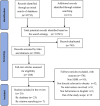Application of system dynamics approach in developing health interventions to strengthen health systems to combat obesity: a systematic literature review and critical analysis
- PMID: 40301836
- PMCID: PMC12039072
- DOI: 10.1186/s12889-025-22821-1
Application of system dynamics approach in developing health interventions to strengthen health systems to combat obesity: a systematic literature review and critical analysis
Abstract
Background: Obesity is an escalating global public health challenge that is expected to impact a significant portion of the world's population in the coming decades. It leads to severe health conditions such as diabetes, cardiovascular diseases, and cancer, imposing significant economic burdens on health systems. Traditional intervention strategies, which emphasize individual lifestyle changes, fail to address the complex, systemic nature of obesity. This study aims to systematically review the application of system dynamics modelling (SDM) in obesity control, focusing on analyzing modelling methodologies and conducting a quality assessment of the included studies.
Methods: Employing a comprehensive systematic literature retrieval, we explored terms pertinent to overweight/obesity and system dynamics across three databases, including PubMed, Web of Science, and Scopus. This search culminated in identifying peer-reviewed studies published from the inception of these databases until July 2024. Quality assessment was used to evaluate the SDM for obesity control. The protocol of this systematic review has been registered on PROSPERO (CRD42024554520).
Results: Thirty studies were identified through a systematic review. These studies primarily focus on the effects of SD approaches, such as individual lifestyle changes, policy interventions within populations, and socio-economic and environmental improvements on obesity control. Among them, eleven studies completed the entire SDM process. Twenty-seven studies presented conceptual models, of which twenty-five developed casual loop diagrams (CLD). Seventeen studies conducted computational system dynamics modelling, with thirteen constructing stock-flow diagrams (SFD). Additionally, fourteen studies performed simulation analyses. These models facilitated multi-level strategies to reduce obesity prevalence.
Conclusions: Using SDM approaches has significant potential to enhance the effectiveness of obesity interventions and optimize resource allocation. Our study into the application of SDM in the design of obesity health interventions revealed its ability to promote multi-level, cross-sectoral cooperation and coordination, thereby enhancing the effectiveness of interventions. Further exploration and optimization of obesity health interventions can significantly advance health systems and welfare.
Keywords: Health interventions; Health systems; Obesity; System dynamics modeling.
© 2025. The Author(s).
Conflict of interest statement
Declarations. Ethics approval and consent to participate: Not applicable. Consent for publication: Not applicable. Competing interests: The authors declare no competing interests.
Figures
Similar articles
-
Beyond the black stump: rapid reviews of health research issues affecting regional, rural and remote Australia.Med J Aust. 2020 Dec;213 Suppl 11:S3-S32.e1. doi: 10.5694/mja2.50881. Med J Aust. 2020. PMID: 33314144
-
The effectiveness of web-based programs on the reduction of childhood obesity in school-aged children: A systematic review.JBI Libr Syst Rev. 2012;10(42 Suppl):1-14. doi: 10.11124/jbisrir-2012-248. JBI Libr Syst Rev. 2012. PMID: 27820152
-
Behavioural interventions for type 2 diabetes: an evidence-based analysis.Ont Health Technol Assess Ser. 2009;9(21):1-45. Epub 2009 Oct 1. Ont Health Technol Assess Ser. 2009. PMID: 23074526 Free PMC article.
-
Public sector reforms and their impact on the level of corruption: A systematic review.Campbell Syst Rev. 2021 May 24;17(2):e1173. doi: 10.1002/cl2.1173. eCollection 2021 Jun. Campbell Syst Rev. 2021. PMID: 37131927 Free PMC article. Review.
-
Reducing obesity and related chronic disease risk in children and youth: a synthesis of evidence with 'best practice' recommendations.Obes Rev. 2006 Feb;7 Suppl 1:7-66. doi: 10.1111/j.1467-789X.2006.00242.x. Obes Rev. 2006. PMID: 16371076 Review.
References
-
- World Obesity Federation. World Obesity Atlas. 2023. https://data.worldobesity.org/publications/?cat=19.
-
- Mohajan D, Mohajan HK. Obesity and its related diseases: a new escalating alarming in global health. J Innov Med Res. 2023;2(3):12–23. 10.56397/JIMR/2023.03.04.
-
- Ryan D, Barquera S, Barata Cavalcanti O, et al. The global pandemic of overweight and obesity: Addressing a twenty-First century multifactorial disease. Handb Glob Health. Cham: Springer International Publishing. 2021; 739–773. 10.1007/978-3-030-45009-0_39.
Publication types
MeSH terms
Grants and funding
- MYRG2022-00113-ICMS; MYRG-GRG2023-00059-ICMS/University of Macau
- MYRG2022-00113-ICMS; MYRG-GRG2023-00059-ICMS/University of Macau
- MYRG2022-00113-ICMS; MYRG-GRG2023-00059-ICMS/University of Macau
- MYRG2022-00113-ICMS; MYRG-GRG2023-00059-ICMS/University of Macau
- MYRG2022-00113-ICMS; MYRG-GRG2023-00059-ICMS/University of Macau
LinkOut - more resources
Full Text Sources
Medical


